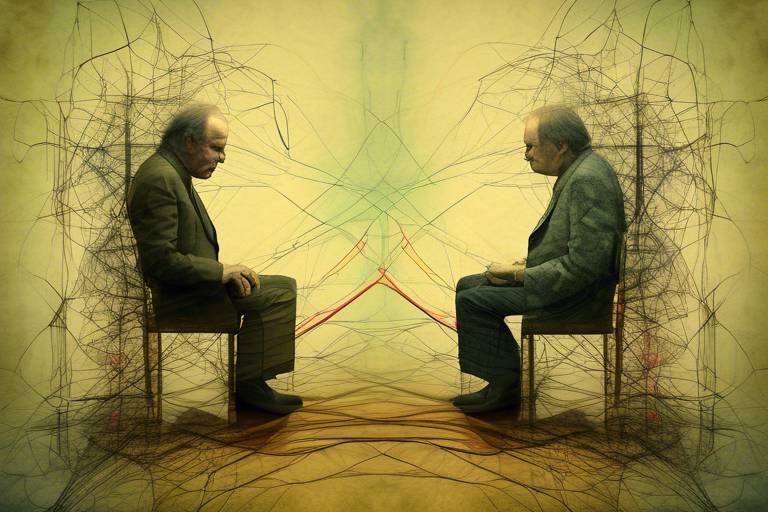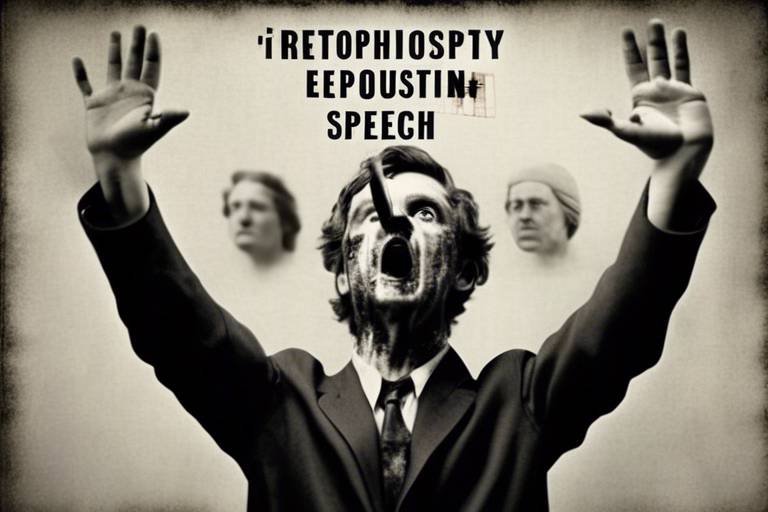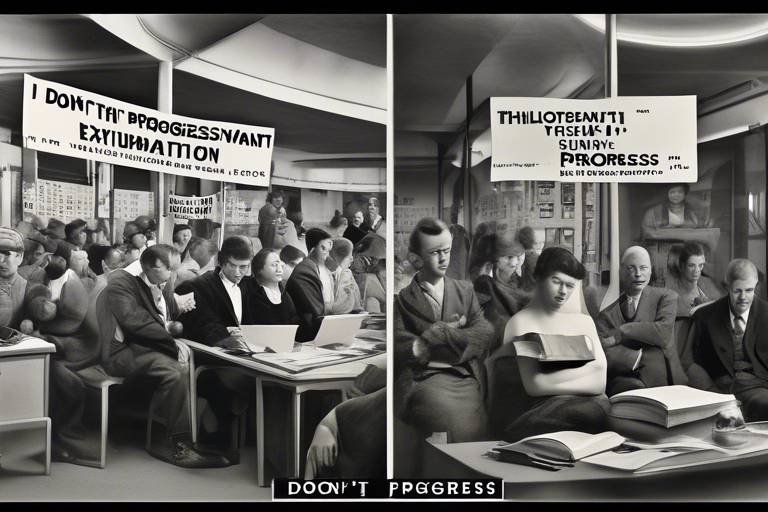Deleuze and Guattari's Rhizome Theory: A Commentary
In the world of philosophy and social theory, few concepts are as intriguing and transformative as Deleuze and Guattari's Rhizome Theory. This revolutionary framework challenges the conventional, hierarchical ways of thinking and organizing knowledge. Imagine a sprawling network of roots, spreading out in all directions, intertwining and connecting with one another. That's the essence of a rhizome—it's not just a plant structure; it's a metaphor for understanding how ideas, cultures, and societies interact in a dynamic and fluid manner.
At its core, Rhizome Theory advocates for a non-linear approach to knowledge and organization, contrasting sharply with traditional tree-like models that impose a clear hierarchy and order. In a rhizomatic system, every node is equal; there are no top-down structures dictating how information flows or how relationships are formed. This perspective opens up a world of possibilities, allowing for more inclusive and diverse interactions. It invites us to think about how we can break free from rigid frameworks that often stifle creativity and innovation.
As we explore the implications of Rhizome Theory, we’ll uncover how it resonates across various fields—from philosophy and art to social structures. This commentary will not only highlight the foundational concepts of rhizomatic thinking but also delve into its profound impact on contemporary discourse. Are we ready to embrace a model that celebrates multiplicity, connectivity, and heterogeneity? Or will we cling to the familiar comforts of hierarchy? The answers lie within the rich tapestry of thought that Deleuze and Guattari have woven for us.
Rhizome Theory presents a fascinating lens through which we can view the complexities of knowledge and organization. Unlike traditional models that often prioritize a single, dominant narrative, rhizomatic thinking encourages us to recognize the value of multiple perspectives. It challenges the notion that there is one correct way to understand the world, instead offering a more fluid and adaptable framework.
This approach has significant implications across various fields. For instance, in philosophy, it invites a reevaluation of how we construct theories and arguments. In art, it fosters a spirit of experimentation and innovation, allowing artists to break free from conventional forms and explore new narratives. In social structures, it emphasizes inclusivity and the importance of diverse voices, reshaping how communities interact and organize themselves.
As we delve deeper into the key principles of rhizomatic thinking, we’ll uncover the richness of its concepts and how they can transform our understanding of the world around us.
At the heart of Rhizome Theory are several key principles that challenge conventional modes of thought and organization. These principles include multiplicity, connectivity, and heterogeneity. Each of these concepts plays a crucial role in shaping how we perceive and engage with knowledge, creativity, and social dynamics.
Multiplicity is a fundamental aspect of rhizomatic thinking, emphasizing the coexistence of diverse elements within a system. Rather than seeking a singular truth, multiplicity allows for various interpretations and interactions to thrive. This idea is particularly powerful in the realms of creativity and knowledge production. Think of it like a vibrant tapestry, where each thread contributes to the overall design, creating a rich and complex picture.
In contemporary art and literature, the influence of rhizomatic multiplicity is evident. Artists and writers are increasingly embracing innovative narratives and experimental styles that reflect the interconnectedness of ideas. For example, the rise of multimedia art integrates various forms of expression, blurring the lines between visual art, performance, and technology. Similarly, in literature, authors are exploring non-linear storytelling and fragmented narratives, allowing readers to engage with the text in a more dynamic way.
The concept of multiplicity also extends to social dynamics, promoting inclusivity and diversity. In a rhizomatic framework, every voice matters, and the interactions between individuals can lead to more robust and resilient communities. This shift encourages us to rethink how we organize ourselves socially, moving away from rigid hierarchies that often marginalize certain groups. Instead, we can foster environments where collaboration and shared knowledge flourish, creating a sense of belonging for all.
Another essential principle of Rhizome Theory is connectivity, which highlights the importance of relationships within a network. In a rhizomatic model, connections are not merely about linear pathways; they are about the intricate web of interrelations that facilitate collaboration and knowledge sharing across disciplines. This interconnectedness allows for a more holistic understanding of complex issues, as insights from one area can inform and enrich another.
When we contrast rhizomatic models with traditional hierarchical structures, we uncover the strengths and weaknesses of each. Traditional hierarchies often impose a rigid framework that can stifle creativity and innovation. In a rapidly changing world, these limitations become increasingly apparent, as organizations and communities struggle to adapt to new challenges and opportunities.
Rigid structures can hinder progress and adaptability in various contexts. For instance, in corporate environments, a top-down approach may lead to decision-making bottlenecks, where innovative ideas are lost in layers of bureaucracy. Similarly, in educational systems, hierarchical models can limit the exploration of diverse perspectives, stifling critical thinking and creativity among students.
On the other hand, rhizomatic models offer flexibility and resilience. They allow for dynamic responses to challenges, fostering environments where creativity can flourish. Organizations that adopt a rhizomatic approach can adapt more readily to change, leveraging the diverse talents and insights of their members. This adaptability not only enhances innovation but also strengthens community ties, creating a sense of shared purpose and collaboration.
- What is Rhizome Theory? Rhizome Theory is a philosophical framework developed by Deleuze and Guattari that emphasizes non-hierarchical organization and the interconnectedness of knowledge.
- How does Rhizome Theory apply to art? It influences artistic expression by encouraging innovative narratives and experimental styles that reflect the multiplicity of perspectives.
- What are the benefits of a rhizomatic approach in social structures? A rhizomatic approach promotes inclusivity, collaboration, and resilience, allowing communities to adapt and thrive.

Understanding Rhizome Theory
At its core, Rhizome Theory, as proposed by Gilles Deleuze and Félix Guattari, presents a revolutionary way of understanding knowledge and organization. Unlike traditional models, which often resemble a rigid tree structure with a clear hierarchy, rhizomatic thinking embraces a more fluid and decentralized approach. Imagine a network of roots sprawling underground, interconnecting in a chaotic yet harmonious manner. This metaphor captures the essence of rhizomes: they grow in multiple directions, intertwining and overlapping, creating a rich tapestry of connections.
In essence, Rhizome Theory invites us to rethink how we perceive relationships, knowledge, and even societal structures. It challenges the notion of a singular path to understanding, suggesting instead that knowledge is not linear but rather a vast, interconnected web. This perspective is particularly relevant in today's fast-paced world, where information flows freely and the lines between disciplines blur. By adopting a rhizomatic approach, we can foster a more inclusive and dynamic environment that encourages creativity and innovation.
One of the most significant implications of Rhizome Theory is its potential to disrupt traditional power dynamics. In a rhizomatic structure, every connection holds equal weight, allowing for a more egalitarian distribution of knowledge and authority. This can lead to a more participatory model of decision-making, where diverse voices contribute to the conversation. The beauty of this model lies in its adaptability; it can evolve and grow as new ideas and connections emerge.
To illustrate the significance of Rhizome Theory, let's delve into its foundational concepts:
- Non-Hierarchy: Unlike traditional structures that prioritize a top-down approach, rhizomes operate on a level playing field.
- Multiplicity: Emphasizing the coexistence of diverse elements, rhizomes encourage various interpretations and interactions.
- Connectivity: Relationships are paramount, as they facilitate collaboration and knowledge sharing across different fields.
- Heterogeneity: Rhizomatic structures thrive on diversity, allowing for a rich array of perspectives and ideas.
In conclusion, Rhizome Theory is not just an abstract philosophical concept; it is a practical framework that can be applied across various fields, from philosophy to art and social structures. By embracing the principles of multiplicity, connectivity, and non-hierarchy, we can cultivate environments that foster creativity, inclusivity, and resilience. As we navigate an increasingly complex world, understanding and implementing rhizomatic thinking may very well be the key to unlocking new possibilities and transformative ideas.

Key Principles of Rhizomatic Thinking
At the heart of Rhizomatic Thinking lie several key principles that challenge our traditional understanding of knowledge, organization, and interaction. Unlike the conventional tree-like structures that suggest a clear hierarchy and a singular path of growth, rhizomatic models embrace a more fluid and interconnected approach. This paradigm shift allows for a richer understanding of how ideas, cultures, and social interactions can flourish. Let's dive deeper into these principles and see how they can transform our perspective.
One of the most significant principles is multiplicity. This concept celebrates the idea that multiple interpretations and meanings can coexist within a system. Imagine a vibrant garden where different plants grow side by side, each contributing to the ecosystem in its unique way. In a rhizomatic framework, diversity isn't just tolerated; it's essential for creativity and innovation. This multiplicity encourages us to explore various viewpoints, leading to richer discussions and a broader range of ideas. For example, in artistic communities, this principle fosters a melting pot of styles and techniques, allowing for groundbreaking works that challenge the status quo.
Another critical aspect is connectivity. Rhizomatic thinking emphasizes the importance of relationships within a network. Think of it as a web where each strand is interconnected, forming a complex tapestry of interactions. These connections facilitate collaboration and knowledge sharing across disciplines, breaking down the silos that often limit creativity. When individuals and groups engage in a rhizomatic manner, they become part of a dynamic ecosystem that thrives on shared experiences and collective intelligence. This interconnectedness not only enhances creativity but also allows for rapid adaptation to changes in the environment.
Furthermore, heterogeneity plays a vital role in rhizomatic thinking. This principle acknowledges that differences are not just obstacles to overcome but are, in fact, sources of strength. In a rhizomatic model, varying perspectives and backgrounds contribute to a richer understanding of complex issues. For instance, in social movements, the inclusion of diverse voices can lead to more comprehensive solutions that address the needs of a broader audience. By valuing heterogeneity, we create spaces where everyone feels represented and heard, fostering a sense of belonging and community.
To illustrate these principles further, consider the following table that summarizes their implications:
| Principle | Description | Implications |
|---|---|---|
| Multiplicity | The coexistence of diverse elements within a system | Encourages creativity and innovation through varied interpretations |
| Connectivity | The importance of relationships within a network | Facilitates collaboration and knowledge sharing |
| Heterogeneity | Valuing differences as strengths | Promotes inclusivity and richer understanding of complex issues |
In conclusion, the key principles of rhizomatic thinking—multiplicity, connectivity, and heterogeneity—offer a refreshing perspective that challenges conventional modes of thought. By embracing these ideas, we can foster environments that are not only more inclusive but also more innovative. As we navigate an increasingly complex world, adopting a rhizomatic approach could be the key to unlocking new possibilities and solutions.
- What is Rhizome Theory? Rhizome Theory is a philosophical concept developed by Gilles Deleuze and Félix Guattari that emphasizes non-hierarchical and interconnected forms of organization.
- How can Rhizomatic Thinking be applied in everyday life? By embracing multiplicity, connectivity, and heterogeneity, individuals can enhance their creativity, foster collaboration, and appreciate diverse perspectives in their daily interactions.
- Why is it important to challenge traditional structures? Traditional structures can stifle innovation and limit adaptability, while rhizomatic models encourage flexibility and responsiveness to change.

Multiplicity in Rhizome Theory
Multiplicity is one of the cornerstones of Rhizome Theory, and it fundamentally reshapes our understanding of systems, whether they be social, artistic, or philosophical. Imagine a garden filled with an array of plants, each thriving in its unique way, yet all interconnected through a vast network of roots. This image encapsulates the essence of multiplicity, where diverse elements coexist, interact, and contribute to a vibrant ecosystem of ideas and expressions. In a world often dominated by rigid structures that favor singular narratives, multiplicity invites us to embrace complexity and variety, allowing for multiple interpretations and perspectives.
At its core, multiplicity emphasizes that no single viewpoint holds absolute truth; instead, there are countless angles from which to approach any given subject. This is particularly relevant in creative fields, where the blending of different influences can lead to groundbreaking innovations. For instance, in contemporary art, artists draw inspiration from a multitude of sources—cultural traditions, personal experiences, and even technological advancements—creating works that reflect a tapestry of influences rather than a linear progression of ideas. Such an approach not only enriches the artistic landscape but also encourages audiences to engage with art on a deeper level, prompting them to explore their own interpretations.
Moreover, multiplicity fosters an environment where collaboration flourishes. When individuals from various backgrounds come together, the potential for creative synergy increases exponentially. This is evident in collaborative projects that merge distinct disciplines—such as visual arts, music, and performance—resulting in innovative forms of expression that challenge conventional boundaries. For example, consider a performance art piece that combines live music, dance, and digital projections. The multiplicity of elements not only captivates the audience but also creates a space for dialogue and interaction, emphasizing the importance of diverse voices in the creative process.
In the realm of knowledge production, multiplicity encourages a departure from traditional, linear modes of learning. Instead of adhering to a fixed curriculum, educational frameworks can benefit from a rhizomatic approach that values diverse perspectives and encourages students to explore various avenues of inquiry. This not only cultivates critical thinking but also prepares individuals to navigate an increasingly complex world where adaptability and open-mindedness are essential skills. By embracing multiplicity, we can create learning environments that reflect the richness of human experience and promote lifelong curiosity.
Ultimately, the implications of multiplicity extend beyond individual creativity and education; they challenge the very foundations of social structures. In a society that often prioritizes uniformity and conformity, embracing multiplicity can lead to greater inclusivity and diversity. When communities recognize the value of varied experiences and perspectives, they become more resilient and better equipped to address the complexities of modern life. This shift towards a multiplicity-oriented mindset can transform how we interact, collaborate, and build relationships, paving the way for a more harmonious coexistence.
- What is Rhizome Theory? Rhizome Theory, developed by Deleuze and Guattari, presents a non-hierarchical approach to knowledge and organization, contrasting traditional tree-like structures.
- How does multiplicity influence creativity? Multiplicity allows for the coexistence of diverse elements, fostering innovation and encouraging various interpretations in artistic expression.
- Can multiplicity reshape social structures? Yes, by promoting inclusivity and diversity, multiplicity can lead to more resilient communities and improved social dynamics.

Applications in Art and Literature
The influence of Rhizome Theory in the realms of art and literature is nothing short of revolutionary. Artists and writers inspired by this theory have embraced the idea of multiplicity, leading to a rich tapestry of creative expressions that challenge traditional narratives. For instance, the concept of a rhizome encourages creators to explore non-linear storytelling, where the plot can branch out in multiple directions, much like the roots of a plant spreading underground. This approach not only captivates the audience but also invites them to engage more actively with the narrative, piecing together the story from various angles.
In contemporary art, we see rhizomatic principles manifesting through collaborative projects that blur the lines between different mediums and disciplines. Artists are increasingly working together across genres, merging visual art with performance, digital media, and even activism. This interconnectedness fosters a vibrant cultural landscape where ideas can proliferate and evolve freely. For example, installations that incorporate audience participation create a dynamic environment, allowing viewers to influence the artwork's meaning and form, reinforcing the idea that art is not a solitary endeavor but a shared experience.
Literature, too, has been transformed by rhizomatic thinking. Authors are experimenting with fragmented narratives and multiple perspectives, reflecting the complexity of modern life. Books like House of Leaves by Mark Z. Danielewski exemplify this shift, as they invite readers to navigate through a labyrinth of footnotes, layers, and textual variations. This multiplicity in literature not only enhances the reading experience but also mirrors the chaotic nature of reality, where multiple truths coexist and inform one another.
Moreover, the rise of digital literature and interactive storytelling platforms has taken rhizomatic principles to new heights. Writers can now create hyperlinked texts that allow readers to choose their own paths through a narrative, resulting in a unique experience for each individual. This adaptability is akin to a rhizome's ability to grow in various directions, emphasizing the importance of connectivity and choice in the creative process.
Ultimately, the applications of Rhizome Theory in art and literature underscore a broader cultural shift towards inclusivity and diversity. By embracing the principles of multiplicity and connectivity, artists and writers are not only redefining their craft but also inviting audiences to participate in a more holistic and interactive experience. This transformation is a testament to the enduring power of Deleuze and Guattari's ideas, proving that creativity thrives in environments where freedom and collaboration reign.
- What is Rhizome Theory?
Rhizome Theory, developed by philosophers Gilles Deleuze and Félix Guattari, presents a non-hierarchical model of knowledge and organization, contrasting with traditional structures. - How does Rhizome Theory apply to art?
In art, Rhizome Theory encourages collaboration and non-linear forms of expression, allowing for diverse interpretations and innovative practices. - Can you give examples of rhizomatic literature?
Books like House of Leaves by Mark Z. Danielewski utilize fragmented narratives and multiple perspectives, embodying rhizomatic principles. - What are the benefits of rhizomatic structures?
Rhizomatic structures promote flexibility, resilience, and inclusivity, fostering environments where creativity and collaboration can flourish.

Impact on Social Structures
The impact of Rhizome Theory on social structures is profound and multifaceted. As we delve into this concept, it's crucial to recognize that rhizomatic thinking promotes a sense of inclusivity and diversity within communities. Unlike traditional hierarchical models, which often prioritize a few voices at the top, rhizomatic structures encourage a more democratic approach where every individual has the potential to contribute. Imagine a garden where every plant has room to grow, intertwining with others to create a vibrant ecosystem; this is the essence of rhizomatic social organization.
In practical terms, rhizomatic social structures can lead to the emergence of new forms of community engagement. For instance, grassroots movements often embody rhizomatic principles by allowing individuals to connect based on shared interests rather than top-down directives. This organic connectivity fosters a sense of belonging and shared purpose, which is essential in today's rapidly changing world. As people engage in collaborative efforts, they not only share knowledge but also cultivate relationships that transcend traditional boundaries.
Furthermore, rhizomatic structures can reshape the way we perceive leadership and authority. In a rhizomatic framework, leadership is not confined to a single individual or a select group; instead, it is distributed among members of the community. This fluidity allows for a more adaptable response to challenges, as different voices can emerge based on the context and needs of the moment. For example, during a crisis, the community may rally around those with specific expertise, creating a dynamic leadership that evolves with the situation.
To illustrate the impact of rhizomatic thinking on social structures, consider the following table that contrasts traditional and rhizomatic approaches:
| Aspect | Traditional Structures | Rhizomatic Structures |
|---|---|---|
| Leadership | Centralized and hierarchical | Distributed and collaborative |
| Decision-Making | Top-down directives | Consensus and collective input |
| Community Engagement | Limited participation | Active involvement from all members |
| Adaptability | Rigid and slow to change | Flexible and responsive |
This table highlights how rhizomatic structures can create more resilient communities capable of adapting to new challenges and opportunities. By promoting a culture of collaboration and shared responsibility, rhizomatic thinking not only enriches social interactions but also empowers individuals to take an active role in shaping their environments.
In conclusion, the impact of Rhizome Theory on social structures is significant, providing a framework that values diversity and connectivity. As we continue to navigate the complexities of modern society, embracing rhizomatic principles could very well be the key to fostering more inclusive and dynamic communities.
- What is Rhizome Theory? Rhizome Theory, developed by Deleuze and Guattari, proposes a non-hierarchical model of knowledge and organization, emphasizing connectivity and multiplicity.
- How does Rhizome Theory apply to social structures? It encourages inclusivity and diversity, allowing for distributed leadership and collaborative decision-making within communities.
- Can Rhizome Theory influence artistic expression? Yes, it fosters innovative narratives and experimental styles, as artists draw from diverse influences and connections.
- What are the advantages of rhizomatic models? They offer flexibility, resilience, and a dynamic response to challenges, promoting adaptability in various contexts.

Connectivity and Interrelation
Connectivity is the lifeblood of rhizomatic thinking. It emphasizes the significance of relationships within a network, showcasing how every element interacts and influences one another. Imagine a vast web of interconnected nodes, where each node represents an idea, a person, or a piece of knowledge. In this vibrant ecosystem, the strength of the connections between these nodes often determines the overall health and dynamism of the entire structure. Unlike traditional hierarchies, where information flows in a top-down manner, rhizomatic networks allow for a more organic, multidirectional flow of ideas and resources.
This notion of connectivity is particularly relevant in today's world, where collaboration and interdisciplinary approaches are becoming increasingly vital. For example, consider a group of artists, scientists, and technologists working together on a project. In a rhizomatic model, each participant brings their unique perspective and expertise to the table, fostering an environment where creativity can flourish. This collaborative spirit not only enhances the quality of the output but also generates a richer, more diverse tapestry of thought and innovation.
Moreover, the concept of interrelation extends beyond mere connections; it encapsulates the idea that every element in a network is influenced by and can influence others. This creates a dynamic interplay where knowledge is not just shared but transformed. For instance, in educational settings, students who engage in collaborative learning experiences often develop a deeper understanding of the material. They are not just passive recipients of information but active participants in a shared journey of discovery.
To illustrate the impact of connectivity and interrelation, consider the following table that contrasts traditional versus rhizomatic approaches in various contexts:
| Aspect | Traditional Structure | Rhizomatic Structure |
|---|---|---|
| Information Flow | Top-down | Multidirectional |
| Collaboration | Limited | Extensive |
| Creativity | Stifled | Enhanced |
| Flexibility | Rigid | Adaptive |
In conclusion, the principles of connectivity and interrelation within rhizomatic thinking not only challenge conventional modes of thought but also pave the way for new possibilities in creativity, collaboration, and knowledge sharing. As we navigate an increasingly complex world, embracing these principles can lead to more resilient and innovative communities, capable of adapting to the ever-changing landscape of ideas and interactions.
- What is Rhizome Theory? Rhizome Theory is a philosophical concept developed by Gilles Deleuze and Félix Guattari that emphasizes non-hierarchical, interconnected structures of knowledge and organization.
- How does connectivity impact creativity? Connectivity fosters collaboration and the exchange of ideas, which enhances creativity by allowing diverse perspectives to come together.
- What are the benefits of a rhizomatic structure? Rhizomatic structures offer flexibility, resilience, and the ability to adapt to changes, making them ideal for dynamic environments.

Rhizomes vs. Traditional Structures
When we think about how knowledge and organizations are structured, it's easy to picture a tree. You know, that classic image with a single trunk branching out into numerous limbs, each representing a different area of knowledge or hierarchy. But what if we flipped that idea on its head? This is where Deleuze and Guattari's Rhizome Theory comes into play, offering a refreshing alternative to the traditional tree-like structures that dominate our understanding of organization and knowledge dissemination.
In a rhizomatic model, there are no strict hierarchies or linear pathways. Instead, knowledge and relationships are interconnected in a vast network, much like the roots of a plant spreading underground. This interconnectedness allows for a fluid exchange of ideas and information, fostering a more inclusive and diverse environment. Imagine a bustling marketplace where ideas are traded freely, rather than a rigid classroom where only one teacher's voice is heard. This dynamic nature of rhizomes encourages adaptability and innovation, essential traits in an ever-evolving world.
To understand the contrast between these two structures, let’s break down their fundamental differences:
| Aspect | Traditional Structures | Rhizomatic Structures |
|---|---|---|
| Hierarchy | Linear and hierarchical | Non-hierarchical and networked |
| Knowledge Flow | Top-down dissemination | Multi-directional exchange |
| Adaptability | Rigid and slow to change | Flexible and responsive |
| Inclusivity | Exclusive and limited | Open and diverse |
This table illustrates how rhizomatic structures not only challenge but also enhance our understanding of knowledge and community interaction. In traditional settings, the flow of information is often one-way, with decisions being made at the top and trickling down to the lower levels. This can create a disconnect, where the voices of those at the bottom are stifled, leading to a lack of innovation and creativity. Conversely, in rhizomatic systems, every participant has the potential to contribute, share, and shape the narrative. This inclusivity fosters a rich tapestry of ideas and perspectives, ultimately leading to a more vibrant and adaptable community.
Moreover, the rigid nature of traditional structures can hinder progress. Picture a large ship navigating through stormy seas; if it’s too rigid, it risks capsizing. In contrast, a rhizomatic model is like a school of fish that can swiftly change direction in response to threats. This flexibility allows organizations to pivot quickly, embracing change rather than resisting it. In a world where the only constant is change, adopting a rhizomatic approach can be a game-changer for communities and organizations alike.
In summary, while traditional structures have their place, they often fall short in fostering a creative and adaptive environment. Rhizomatic models, with their emphasis on connectivity and inclusivity, present a compelling alternative that resonates with the realities of contemporary society. As we continue to explore these ideas, it becomes clear that embracing a rhizomatic approach may very well be the key to thriving in an interconnected world.
- What is Rhizome Theory? Rhizome Theory, proposed by Deleuze and Guattari, suggests a non-hierarchical model of knowledge and organization, contrasting with traditional, tree-like structures.
- How does Rhizome Theory apply to art and literature? It encourages multiplicity and diversity, allowing for innovative narratives and experimental styles in artistic expression.
- Why are traditional structures limited? Traditional structures often stifle creativity and slow down adaptability due to their rigid hierarchies.
- What are the benefits of rhizomatic structures? They promote flexibility, inclusivity, and a dynamic response to challenges, enhancing collaboration and knowledge sharing.

Hierarchical Limitations
When we think about traditional hierarchical structures, it's easy to picture a well-organized tree, with each branch representing a level of authority or knowledge. However, this tree-like model has some significant limitations that can stifle creativity and innovation. In a world that thrives on speed and adaptability, these rigid frameworks often become more of a hindrance than a help. Imagine trying to navigate a maze with only one path; that's what hierarchical systems can feel like. They dictate a linear flow of information and ideas, leaving little room for deviation or exploration.
One of the primary issues with hierarchical structures is their tendency to create silos. These silos can lead to a lack of communication between different levels of an organization or different departments, which ultimately stifles collaboration. For instance, if a marketing team is working in isolation from the product development team, how can they effectively promote a product that they don’t fully understand? This disconnect can result in missed opportunities and a disjointed approach to problem-solving.
Furthermore, hierarchical systems often prioritize conformity over individuality. Employees may feel pressured to adhere strictly to established protocols and norms, which can suppress innovative thinking. When individuals are discouraged from expressing unique ideas or challenging the status quo, organizations risk stagnation. This is particularly detrimental in creative fields, where fresh perspectives are essential for growth and evolution.
Another limitation is the slow decision-making process inherent in hierarchical structures. When decisions must ascend through multiple layers of authority, it can lead to delays that are detrimental in fast-paced environments. For example, consider a tech startup that needs to pivot quickly in response to market changes. If they are bogged down by a bureaucratic hierarchy, they may miss critical opportunities to innovate or address customer needs promptly.
In contrast, rhizomatic structures encourage a more fluid and dynamic approach. By promoting decentralized decision-making and collaborative networks, organizations can foster an environment where creativity flourishes. This leads to a culture that not only embraces change but actively seeks it out, allowing for rapid adaptation to new challenges. To illustrate this point, let's take a look at a simple comparison:
| Feature | Hierarchical Structures | Rhizomatic Structures |
|---|---|---|
| Decision-Making | Slow and multi-layered | Fast and decentralized |
| Communication | Siloed and limited | Open and collaborative |
| Innovation | Conformity-driven | Creativity-embracing |
| Adaptability | Rigid and slow | Flexible and responsive |
Ultimately, while hierarchical systems have their place, it is crucial to recognize their limitations, especially in today’s fast-evolving landscape. By understanding these shortcomings, organizations can begin to explore alternative models that promote inclusivity and innovation. After all, in a world that is increasingly interconnected, the ability to adapt and thrive often hinges on the structures we choose to adopt.
- What is Rhizome Theory? - Rhizome Theory is a philosophical concept developed by Gilles Deleuze and Félix Guattari that emphasizes non-hierarchical and decentralized forms of knowledge and organization.
- How does Rhizome Theory apply to creativity? - It promotes multiplicity and connectivity, allowing for diverse interpretations and collaborative efforts, which can lead to innovative artistic expressions and ideas.
- What are the advantages of rhizomatic structures over hierarchical ones? - Rhizomatic structures are more adaptable, encourage open communication, and foster a culture of creativity, making them more suited for fast-paced environments.

Advantages of Rhizomatic Models
When we dive into the world of rhizomatic models, we uncover a treasure trove of advantages that can transform how we think, create, and interact. Unlike traditional hierarchical structures that often resemble rigid trees, rhizomatic models are more like sprawling networks of roots that interconnect in unexpected ways. This flexibility allows for a dynamic response to challenges, fostering an environment where creativity and innovation can flourish. Imagine a garden where every plant has the freedom to grow in its own direction; that’s the essence of a rhizomatic approach.
One of the standout benefits of rhizomatic models is their inherent adaptability. In a world that is constantly shifting—think of the rapid advancements in technology or the evolving nature of social interactions—having a structure that can bend and weave with these changes is crucial. Organizations that adopt a rhizomatic approach can pivot more easily, responding to new opportunities and threats without being bogged down by bureaucratic red tape. This adaptability is not just a luxury; it’s a necessity for survival in today’s fast-paced environment.
Moreover, rhizomatic models promote collaboration across various disciplines. In traditional setups, information often flows in a top-down manner, which can lead to silos where knowledge is hoarded rather than shared. In contrast, rhizomatic structures encourage open communication and the free exchange of ideas. This interconnectedness can lead to innovative solutions that might never emerge in a more hierarchical framework. For instance, when artists, scientists, and technologists collaborate in a rhizomatic network, they can create groundbreaking projects that push the boundaries of their respective fields.
Another advantage lies in the promotion of diversity and inclusivity. Rhizomatic models inherently value multiple perspectives, which can lead to richer discussions and more comprehensive solutions. By embracing a variety of voices and experiences, communities can ensure that all members feel represented and heard. This inclusivity not only strengthens social bonds but also enhances the collective intelligence of the group. Think of it as a potluck dinner where everyone brings their unique dish; the result is a feast that reflects the diverse tastes and cultures of the participants.
To illustrate these points, let’s consider a few key areas where rhizomatic models shine:
| Area | Rhizomatic Advantage |
|---|---|
| Business | Enhanced adaptability to market changes |
| Education | Facilitated collaboration among students and teachers |
| Art | Diverse creative expressions leading to innovative works |
| Community | Stronger social ties through inclusivity |
In summary, the advantages of rhizomatic models are manifold. They allow for a more adaptable, collaborative, and inclusive approach to problem-solving and creativity. As we continue to navigate the complexities of modern life, embracing these models can lead to not only individual growth but also a more resilient and interconnected society.
- What is a rhizomatic model? A rhizomatic model is a non-hierarchical structure that emphasizes connectivity and multiplicity, allowing ideas and relationships to flourish in a network-like fashion.
- How does rhizomatic thinking benefit creativity? By promoting diverse perspectives and collaboration, rhizomatic thinking encourages innovative solutions and creative expressions that might not emerge in traditional settings.
- Can rhizomatic models be applied in business? Absolutely! Businesses that adopt rhizomatic structures can adapt more quickly to market changes and foster a culture of collaboration and inclusivity.
- What are the limitations of traditional hierarchical structures? Traditional hierarchies can stifle creativity and slow down decision-making processes, making it difficult for organizations to adapt to change.
Frequently Asked Questions
- What is Deleuze and Guattari's Rhizome Theory?
Rhizome Theory is a philosophical concept that presents a non-hierarchical approach to knowledge and organization. Unlike traditional tree-like structures that have a clear top-down hierarchy, rhizomes promote a more complex and interconnected model where ideas and elements can exist in multiple relationships and pathways.
- How does Rhizome Theory apply to art and literature?
In art and literature, Rhizome Theory encourages multiplicity and diversity, leading to innovative narratives and experimental styles. Artists and writers can draw from various influences and perspectives, creating works that reflect a rich tapestry of ideas rather than a singular, linear narrative.
- What are the key principles of rhizomatic thinking?
The core principles of rhizomatic thinking include multiplicity, connectivity, and heterogeneity. These principles challenge conventional modes of thought by emphasizing the coexistence of diverse elements, the importance of relationships within networks, and the value of varied interpretations and interactions.
- How does Rhizome Theory influence social structures?
Rhizome Theory promotes inclusivity and diversity in social dynamics. By encouraging non-hierarchical interactions, it reshapes community engagement and social organization, allowing for more collaborative and adaptive ways of relating to one another.
- What are the limitations of traditional hierarchical structures?
Traditional hierarchical structures can stifle creativity and innovation due to their rigid nature. These limitations can hinder progress and adaptability, making it difficult for organizations and communities to respond effectively to changes and challenges in their environments.
- What are the advantages of rhizomatic models?
Rhizomatic models offer flexibility and resilience, allowing for dynamic responses to challenges. They enable organizations and communities to adapt more readily to new circumstances, fostering environments where creativity and collaboration can thrive.


















